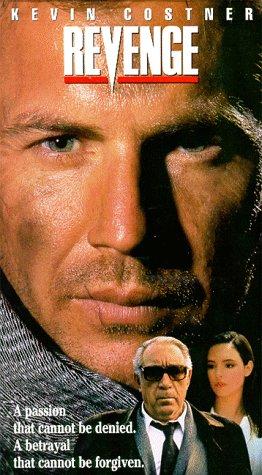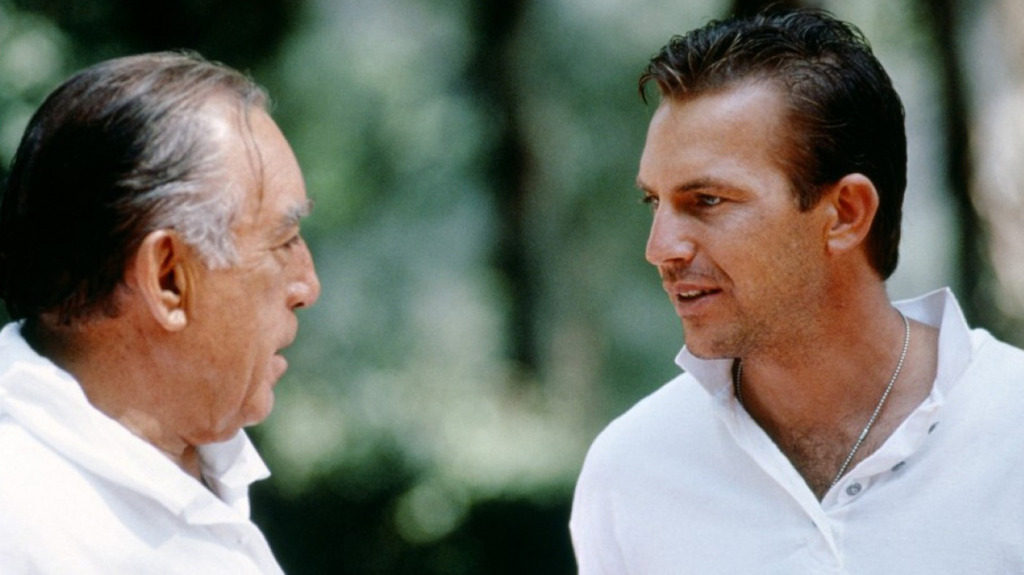DIRECTED BY TONY SCOTT/1990
 Originally written in June of 2014 for a “Film Admissions“-style feature at the site now known as ScreenAnarchy, Revenge was my entry for a site-wide Tony Scott group piece. For the first time anywhere, this is my full text (it was cut to roughly have this length for previous publication) on the violent Kevin Costner vehicle, an interesting curio that found the late Scott at a stylistic crossroads:
Originally written in June of 2014 for a “Film Admissions“-style feature at the site now known as ScreenAnarchy, Revenge was my entry for a site-wide Tony Scott group piece. For the first time anywhere, this is my full text (it was cut to roughly have this length for previous publication) on the violent Kevin Costner vehicle, an interesting curio that found the late Scott at a stylistic crossroads:
*****
Tony Scott’s movies have almost always left me cold. The biggest exception being 1993’s True Romance – a crackling success I’ve always credited in part to its screenwriter Quentin Tarantino. Tarantino himself, however, has always been impartial to another violent Tony Scott yarn, 1990’s Revenge.
Although Revenge presents itself as an edgy, R-rated Kevin Costner vehicle, the strengths of its surrounding elements – the unrelenting sunbaked Mexican terrain, the gauzy smoky interiors, and most importantly, straightforwardness of the storytelling – make it no surprise that it’s found a fan with the man who went on to make Pulp Fiction and Kill Bill. Scott nails both the 1990-era brutal violence and the front-loaded sexiness of the illicit affair that brings about so much trouble within the tale.
Costner starts the film flying an F-15 in peacetime, a popular fighter pilot with movie star good looks. He’s the coolest hot dog in his squadron, all of which renders Revenge a twisted Top Gun 2. But as soon as his feet hit the ground, he retires from the Air Force. The first thing he does is go visit his old pal Anthony Quinn, a wealthy “businessman” whose criminal enterprises seems to have somehow eluded our hero.

Quinn and Costner in REVENGE.
Driving in the front gate of the compound, he immediately falls hard for Quinn’s hot young wife – or at least her rear end in horse riding pants. (Such is the camera’s gaze – what’s a fella to do??). She may be one hot dish, especially once the movie star adultery gets the moral green light from the screenplay and audience, thanks to the scene preceding it of Quinn horribly brutalizing some guy (See?? He doesn’t deserve her!), but things cool pretty quickly once the old man decides it’s time to make good on the movie’s title. In any case, once this maverick’s been goosed, he’s in a danger zone of Kenny Loggins’ worst nightmare.
Scott nails both the 1990-era brutal violence and the front-loaded sexiness of the illicit affair that brings about so much trouble within the tale.
Recently, the other Scott brother, the older and more cloutish Ridley, gave the world a similar attempt, the Cormac McCarthy penned The Counselor. Although feminist critics may be inclined to give the edge to Ridley for treating his female leads as something more than piece-of-meat plot motivation (even as Cameron Diaz has weird sex with a car windshield), Tony’s Revenge gets the overall filmmaking edge by far, if only for virtue of cohesive storytelling. (The Counselor is anything but.). The story may be a sole and overly familiar one, but if you watched it with the sound off, it would play tremendously as the silent movie that Peckinpah never made. (And is Miguel Ferrer’s on-and-gone drunken guide supposed to be the spiritual presence of Bloody Sam, serving as Costner’s guide through Alfredo Garcia‘s hellhole of Mexico?)

Straddling that then-ubiquitous late eighties Miami Vice aesthetic of blue light through shears, misty cinematography, and arbitrary pink neon, and the hyper-saturated edginess and tension-inducing “grainy sharpness”, the well-stylized Revenge is by both the Tony Scott who dazzled so effectively with early career head-turners like The Hunger, and the frazzled Tony Scott, then yet to fully hit, who’d deliver many a mixed bag of machismo such as Man on Fire (among his best), Unstoppable (meh) and Domino (wugh?).
It’s Scott’s touch (his push? His punch?) that makes the unnecessary indulgence that is Revenge work, then and now. Costner’s presence may’ve put butts in seats in Dances with Wolves 1990, but today the actor’s merely a utilitarian non-presence at best. Anthony Quinn does b-movie bloodthirsty well – in his old age he’s wandered a long way from La Strada. Madeline Stowe is the big loser in all of it, going from plot point pleasure center to Mexican whorehouse to worse. (Like I said, not exactly feminist-friendly fare).
Despite it’s shortcomings, the material, for what it’s worth, found the right director. Or, as fanboy Tarantino once quoted in his own such film, Revenge is a dish best served cold.

